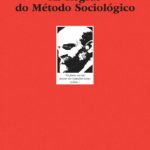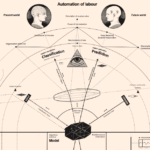![O uso humano de seres humanos (Wiener 1989 [1950]) O uso humano de seres humanos (Wiener 1989 [1950])](https://www.laspa.slg.br/wp-content/uploads/2021/04/wiener_capa-642x1024.jpg)
O uso humano de seres humanos (Wiener 1989 [1950])
WIENER, Norbert. 1989. The human use of human beings: Cybernetics and society. London: Free Association Books. [1950]
SOCIOLOGIA WIENERIANA
It is the thesis of this book that society can only be understood through a study of the messages and the communication facilities which belong to it; and that in the future development of these messages and communication facilities, messages between man and machines, between machines and man, and between machine and machine, are destined to play an ever increasing part. (Wiener 1989:16)
This matter of social feedback is of very great so- ciological and anthropological interest. The patterns of communication in human societies vary widely. (Wiener 1989:50)
ANTI-ANTROPOLOGIA WIENERIANA
When I give an order to a machine, the situation is not essentially different from that which arises when I give an order to a person. In other words, as far as my consciousness goes I am aware of the order that has gone out and of the signal of compliance that has come back. To me, personally, the fact that the signal in its intermediate stages has gone through a machine rather than through a person is irrelevant and does not in any case greatly change my relation to the signal. (Wiener 1989:16)
ORDER-INFORMATION AGAINST NATURE-ENTROPY
The commands through which we exercise our control over our environment are a kind of information which we impart to it. Like any form of information, these commands are subject to disorganization in transit. They generally come through in less coherent fashion and certainly not more coherently than they were sent. In control and communication we are always fighting nature’s tendency to degrade the organized and to destroy the meaningful; the tendency, as Gibbs has shown us, for entropy to increase. (Wiener 1989:17)
INFORMATION
Information is a name for the content of what is exchanged with the outer world as we adjust to it, and make our adjustment felt upon it. The process of receiving and of using information is the process of our adjusting to the contingencies of the outer environ- ment, and of our living effectively within that environment. (Wiener 1989:17-8)
It is, of course, possible that the relation between the line and the terminal machine is so perfect that the amount of information contained in a message, from the point of view of the carrying capacity of the line, and the amount of information of the fulfilled orders, measured from the point of view of the operation of the machine, will be identical with the amount of in- formation transmitted over the compound system consisting of the line followed by the machine. In general, however, there will be a stage of translation between the line and the machine; and in this stage, information may be lost which can never be regained Indeed, the process of transmitting information may involve several consecutive stages of transmission following one another in addition to the final or effective stage; and between any two of these there will be an act of translation, capable of dissipating information. That information may be dissipated but not gained, is, as we have seen, the cybernetic form of the second law of thermodynamics. (Wiener 1989:78)
[i]t is not the quantity of information sent that is important for action, but rather the quantity of information which can penetrate into a communication and storage apparatus sufficiently to serve as the trigger for action. (Wiener 1989:93-4)
What is important is not merely the information that we put into the line, but what is left of it when it goes through the final machinery to open or close sluices, to synchronize generators, and to do similar tasks. In one sense, this terminal apparatus may be regarded as a filter superimposed on the trans- mission line. Semantically significant information from the cybernetic point of view is that which gets through the line-plus-filter, rather than that which gets through the line alone. […] Semantically significant information in the machine as well as in man is information which gets through to an activating mechanism in the system that receives it, despite man’s and/or nature’s attempts to subvert it. (Wiener 1989:94)
CYBERNETIC CIGAR
If I pick up my cigar, I do not will to move any specific muscles. Indeed in many cases, I do not know what those muscles are. What I do is to turn into action a certain feedback mechanism; namely, a reflex in which the amount by which I have yet failed to pick up the cigar is turned into a new and increased order to the lagging muscles, whichever they may be. In this way, a fairly uniform voluntary command will enable the same task to be performed from widely varying initial positions, and irrespective of the decrease of con- traction due to fatigue of the muscles. (Wiener 1989:26)
TESE
It is my thesis that the physical functioning of the living individual and the operation of some of the newer communication machines are precisely parallel in their analogous attempts to control entropy through feed- back. (Wiener 1989:26)
LEARNING REFLEX
[F]eedback, [is] the property of being able to adjust future conduct by past performance. Feedback may be as simple as that of the common reflex, or it may be a higher order feedback, in which past experience is used not only to regulate specific movements, but also whole policies of behavior. Such a policy-feedback may, and often does, appear to be what we know under one aspect as a conditioned reflex, and under another as learning. (Wiener 1989:33)
I repeat, feedback is a method of controlling a system by reinserting into it the results of its past performance. If these results are merely used as numerical data for the criticism of the system and its regulation, we have the simple feedback of the control engineers. If, however, the information which proceeds backward from the performance is able to change the general method and pattern of performance, we have a process which may well be called learning.(Wiener 1989:61)
REDUCING THE FUTURE TO THE PAST
Thus the nervous system and the automatic machine are fundamentally alike in that they are devices which make decisions on the basis of decisions they have made in the past. (Wiener 1989:33)
DECADANCE AVEC ELEGANCE
In a very real sense we are shipwrecked passengers on a doomed planet. Yet even in a shipwreck, human decencies and human values do not necessarily vanish, and we must make the most of them. We shall go down, but let it be in a manner to which we may look forward as worthy of our dignity. (Wiener 1989:40)
TEMPORALIDADE (feedback)
[T]he environment, considered as the past experience of the individual, can modify the pattern of behavior into one which in some sense or other will deal more effectively with the future environment. (Wiener 1989:48)
FASCIST ANTS
While it is possible to throw away this enormous advantage that we have over the ants, and to organize the fascist ant-state with human material, I certainly believe that this is a degradation of man’s very nature, and economically a waste of the great human values which man possesses. […] I am afraid that I am convinced that a community of human beings is a far more useful thing than a community of ants; and that if the human being is condemned and restricted to perform the same functions over and over again, he will not even be a good ant, not to mention a good human being.(Wiener 1989:52)
MEMORY
The physiological condition for memory and hence for learning seem.s to be a certain continuity of organization, which allows the alterations produced by outer sense impressions to be retained as more or less permanent changes of structure or function. (Wiener 1989:55)
“ONE-HOSS SHAY” (Oliver Wendell Holmes); O ANTI-SIMONDON (anti-manutenção)
This hoary vehicle, as you recollect, after one hundred years of service, showed itself to be so carefully designed that neither wheel, nor top, nor shafts, nor seat contained any part which manifested an uneconomical ex- cess of wearing power over any other part. Actually, the “one-boss shay” represents the pinnacle of engineering, and is not merely a humorous fantasy. If the tires had lasted a moment longer than the spokes or the dashboard than the shafts, these parts would have carried into disuse certain economic values. These values could either have been reduced without hurting the durability of the vehicle as a whole, or they could have been transferred equally throughout the entire vehicle to make the whole thing last longer. Indeed, any structure not of the nature of the “one-boss shay” is wastefully designed. (Wiener 1989:60)
IF…
If then, it is possible without excessive cost to devise an apparatus which will record my past conversations, and reapportion to me a degree of service corresponding to the frequency of my past use of the telephone channels, I should obtain a better service, or a less expensive one, or both. (Wiener 1989:60)
PREDICTING MACHINES THAT KILL
Another example of the learning process appears in connection with the problem of the design of prediction machines. At the beginning of World War II, the comparative inefficiency of anti-aircraft fire made it necessary to introduce apparatus which would follow the position of an airplane, compute its distance, determine the length of time before a shell could reach it, and figure out where it would be at the end of that time. If the plane were able to take a perfectly arbitrary evasive action, no amount of skill would permit us to fill in the as yet unknown motion of the plane between the time when the gun was fired and the time when the shell should arrive approximately at its goal. However, under many circumstances the aviator either does not, or cannot, take arbitrary evasive action. He is limited by the fact that if he :makes a rapid turn, centrifugal force will render him unconscious; and by the other fact that the control mechanism of his plane and the course of instructions which he has received practically force on him certain regular habits of control which show themselves even in his evasive action. These regularities are not absolute but are rather statistical preferences which appear most of the time. (Wiener 1989:61)
WORLD STATE
It is even possible to maintain that modem communication, which forces us to adjudicate the international claims of different broadcasting systems and different airplane nets, has made the World State inevitable. (Wiener 1989:92)
HOMEOSTASISLAND
Life is an island here and now in a dying world. The process by which we living beings resist the general stream of corruption and decay is known as homeostasis. (Wiener 1989:97)
THE PATTERN THAT CONNECTS
It is the pattern maintained by this homeostasis, which is the touchstone of our personal identity. Our tissues change as we live: the food we eat and the air we breathe become flesh of our flesh and bone of our bone, and the momentary elements of our flesh and bone pass out of our body every day with our excreta. We are but whirlpools in a river of ever-flowing water. We are not stuff that abides, but patterns that perpetuate themselves. […] A pattern is a message, and may be transmitted as a message. (Wiener 1989:96)
the individuality of the body is that of a flame rather than that of a stone, of a form rather than of a bit of substance. (Wiener 1989:102)
TELE
To see and to give commands to the whole world is almost the same as being everywhere. (Wiener 1989:97)
AMERICANS
I am writing this book primarily for Americans in whose environment questions of information will be evaluated according to a standard American criterion: a thing is valuable as a commodity for what it will bring in the open market. […] The fate of information in the typically American world is to become something which can be bought or sold. (Wiener 1989:113)
INVENTION
Invention came to mean [with Thomas Edison], not the gadget-insight of a shop-worker, but the result of a careful, comprehensive search by a team of competent scientists. (Wiener 1989:115)
SCIENCE
Scientific discovery consists in the interpretation for our own convenience of a system of existence which has been made with no eye to our convenience at all. (Wiener 1989:124)
TECHNOSLAVES
Let us remember that the automatic machine, whatever we think of any feelings it may have or may not have, is the precise economic equivalent of slave labor. (Wiener 1989:162)





 O LaSPA é sediado no Instituto de Filosofia e Ciências Humanas (
O LaSPA é sediado no Instituto de Filosofia e Ciências Humanas (